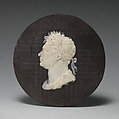Wax model for a portrait of King George IV (1762–1830)
Benedetto Pistrucci Italian
Trained in his native Rome, Benedetto Pistrucci (1783-1855) arrived in London in 1815 and found great success among a group of influential British patrons, eventually rising to the position of Chief Medallist for the Royal Mint in 1828. The proud and irascible Pistrucci often courted controversy with his dilatory working habits and his insistence on working from live models and refusal to base his designs on other artist’s precedents. The Met contains several examples of Pistrucci’s medals, coins, and cameos. These include Pistrucci’s coins for George III, some of which feature his famed design of Saint George and the Dragon on the reverse (for example, 2000.224.2); the coronation medal for George IV (2001.217.1), an electrotype of his much-delayed Waterloo Medal, commemorating Napoleon’s defeat (2005.109), and his elegant work in cameos, including his masterpiece, the Head of Medusa in red jasper (2003.431).
Here, on a thin, circular disc of gray slate, Pistrucci modeled in white wax a laureate bust profile portrait of the Sovereign, wearing a chlamys and facing left. Pistrucci sculpted the portrait in extremely shallow relief; certain sections—those at the wax’s edge, including the nose, the ends of the hair, laureate, and portions of the sitter’s cloak—appear translucent. Despite the thinness of the wax, Pistrucci is able to convey a strong sense of modeling and three dimensionality, particularly around the jowls, cheeks, chin, and nose. The object contains precious evidence of the talented sculptor’s working methods, including grid lines for squaring, and a circle, drawn with a compass, with X-marks placed at regular intervals. These marks can either have been used for centering the wax relief within the parameters of the slate or for transferring the portrait onto metal.
Waxes by Pistrucci outside of his native Rome are extremely rare. The nearly 400 waxes left with the artist’s family upon his death in 1855 entered the collection of Rome’s treasury, now the Museo della Zecca (Museum of the Mint), in the early twentieth century. Pistrucci’s wax relief of George IV (r. 1820-1830) cannot be connected to an existing produced medal and thus is likely an early, unused preparatory model, comparable to several in the Museo della Zecca dating to 1820-1821, that is, the beginning of George IV’s official reign.
Due to rights restrictions, this image cannot be enlarged, viewed at full screen, or downloaded.

